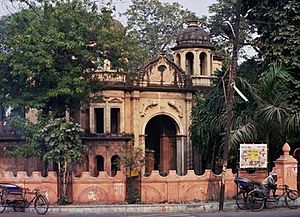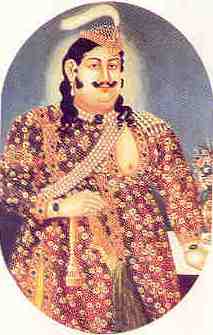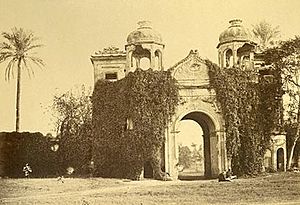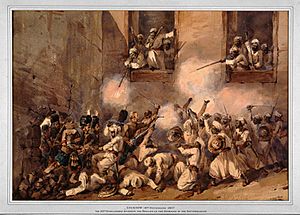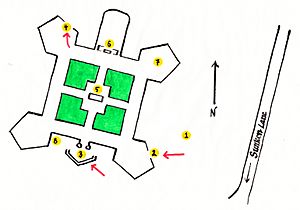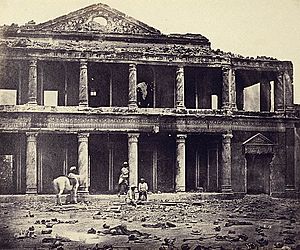Sikandar Bagh facts for kids
Sikandar Bagh (Hindi: सिकन्दर बाग़, Urdu: سِکندر باغ) is a historic building and garden in Lucknow, Uttar Pradesh, India. It was once called Sikunder Bagh by the British. This special place includes a large house and a garden surrounded by a strong wall. The wall has small openings for defense, a main gate, and towers at the corners. It covers about 4.5 acres (1.8 hectares).
The last ruler of Oudh, Wajid Ali Shah (who lived from 1822 to 1887), built Sikandar Bagh as a summer home. The name "Sikandar Bagh" means "Garden of Sikandar." It was named after Sikandar Mahal Begum, one of the Nawab's favorite wives.
In 1857, during the Indian Rebellion, British forces attacked Sikandar Bagh. Many Indian soldiers, called sepoys, had made it a strong base. A fierce battle took place there, and many lives were lost. Today, the site is home to the National Botanical Research Institute of India.
Contents
The Garden's Beginning
The garden was first created around 1800 by Nawab Saadat Ali Khan II. Later, Nawab Wajid Ali Shah, the last ruler of Oudh, made it even better in the early 1800s. He used it as his special summer house.
There is a small building in the middle of the garden. This building was likely used for many cultural events. These included traditional Indian dances like Ras-lilas and Kathak, music shows, and poetry gatherings. Nawab Wajid Ali Shah loved these activities very much.
Sikandar Bagh in the Indian Rebellion
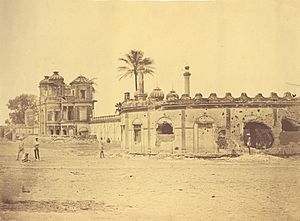
During the Indian Rebellion of 1857, Sikandar Bagh became an important stronghold for the Indian soldiers, or sepoys. They were fighting against the British and had surrounded the British Residency in Lucknow.
The British Commander-in-Chief, Sir Colin Campbell, needed to pass Sikandar Bagh to help the British trapped in the Residency. On the morning of November 16, 1857, British forces were moving along a sunken road near Sikandar Bagh. Suddenly, heavy gunfire came from the garden, stopping them.
It was very difficult for the British to advance. However, a brave officer named Blunt from the Bengal Horse Artillery managed to bring his guns into an open area. He set up his six guns and began firing at Sikandar Bagh. Engineers also broke down parts of the earth banks. This allowed two large 18-pounder guns to be brought closer.
After about 30 minutes of firing from only 80 yards away, a small opening was made in the wall. It was a bricked-up doorway, about 3 feet square and 3 feet off the ground. Even though it was hard for one person to get through, soldiers from the 93rd Highlanders and the 4th Punjab Infantry immediately rushed towards it under heavy fire. About 14 men managed to get inside.
At the same time, other soldiers from the 4th Punjab Infantry attacked the main gate. The Indian defenders were trying to close the gate. But a brave officer named Subadar Mukarab Khan, from the 4th Punjab Infantry, put his arm and shield between the gate folds. This stopped it from closing completely. Even though he was wounded, he held it open until more British soldiers forced their way in.
Once inside, a long hand-to-hand fight began. The British forces pushed further into Sikandar Bagh. The main group of about 2,000 Indian soldiers retreated into a large two-story building and a walled area behind it. The doors to this area were attacked by the 4th Punjab Infantry. The Indian soldiers had blocked their own escape route by bricking up a back door. After a fierce struggle, all the defenders were defeated.
Many British soldiers were very angry because of earlier events in the rebellion, especially the terrible killings of European civilians, including women and children, during the Siege of Cawnpore. Lord Roberts, who saw the attack, later described the scene. He said the defeated soldiers were pushed back into a pile, where they were killed. He called it a "sickening site" and a "horrible side to war."
During this attack, 9 officers and 90 men from the 93rd Highlanders were killed or wounded. Also, 3 officers and 69 men from the 4th Punjabi Infantry were killed or wounded.
Map of the Attack
Key:
- (1) Where the 18-pounder guns were placed.
- (2) The hole made in the wall.
- (3) The main gate.
- (4) A tower attacked from inside by the 4th Punjab Infantry Regiment, stopping the enemy's escape.
- (5) The central building with a porch.
- (6) A one-story building overlooking the garden with its own courtyard.
- (7) The east tower, which exploded, killing Lt. Paul, who was leading the 4th P.I.
- (8) The spot where Sir Colin Campbell, the Commander-in-Chief, and his staff stayed from November 18 to 22.
What Happened After
After the battle, the British and their loyal Indian Punjab Infantry soldiers who died were buried in a deep trench. Later, elephants were used to pull the bodies of the Indian soldiers out of Sikandar Bagh. They were then lightly covered in a ditch outside the north wall. This ditch had been dug by the Indian soldiers themselves to make their defenses stronger.
The 4th Punjab Infantry stayed at Sikandar Bagh until the British left Lucknow 11 days later, on November 27. Sir Colin Campbell and his staff stayed near the gate from November 18 to 22.
In early 1858, a photographer named Felice Beato took pictures of Sikandar Bagh. Some photos showed bones scattered across the ground inside. It seems these bones were moved or arranged to make the pictures look more dramatic.
Victoria Crosses Given Out
It is said that many Victoria Cross medals were given out for bravery on that single day, especially for the attack on Sikandar Bagh. The Victoria Cross is the highest military award for bravery in the British armed forces.
Here are some of the soldiers who received the award:
- 53rd Regiment of Foot
- Private Charles Irwin - He was among the first to enter the building.
- Private James Kenny - He showed bravery and brought ammunition under fire.
- Lieutenant Alfred Ffrench - He was one of the first officers to enter the building.
- 90th Regiment of Foot
- Sergeant Samuel Hill and Major John Guise - They helped wounded soldiers.
- 93rd Regiment of Foot (Sutherland Highlanders)
- Captain William Stewart
- Colour Sergeant James Munro - He rescued Captain Walsh.
- Sergeant David Mackay
- Sergeant John Paton
- Lance Corporal John Dunlay
- Private Peter Grant
- 1st Madras (European) Fusiliers
- Private John Smith
- 1st Bengal (European) Fusiliers
- Lieutenant Francis Brown - He helped a wounded soldier.
- HMS Shannon's Naval Brigade
- Lieutenant Nowell Salmon
- Lieutenant Thomas Young - He and William Hall kept their guns firing even after other gun crews were hurt.
- Leading Seaman John Harrison
- Foretop Captain William Hall
- Able Seaman Edward Robinson
Memories of the Battle
Today, you can still see reminders of the battle at Sikandar Bagh. Things like cannonballs, swords, shields, and parts of old guns have been found in the garden over the years. These items are now on display at the NBRI Exhibition. You can also see scars from cannonballs on the old walls of the garden, showing where the fighting happened.
Another important reminder is the statue of Uda Devi. She was a brave woman from the Pasi community (a Dalit group) who fought alongside the Indian soldiers. She dressed in men's battle clothes and climbed a tree in the garden. From there, she fired her gun at the British attackers. She kept fighting until she ran out of ammunition, and then she died from her wounds.
Legend says that Uda Devi was one of Nawab Wajid Ali Shah's female bodyguards. She was very loyal and skilled in martial arts and spying. She also learned guerrilla warfare tactics. The British soldiers were surprised by her excellent shooting skills until they finally spotted her and fired at her until she died.
Images for kids


